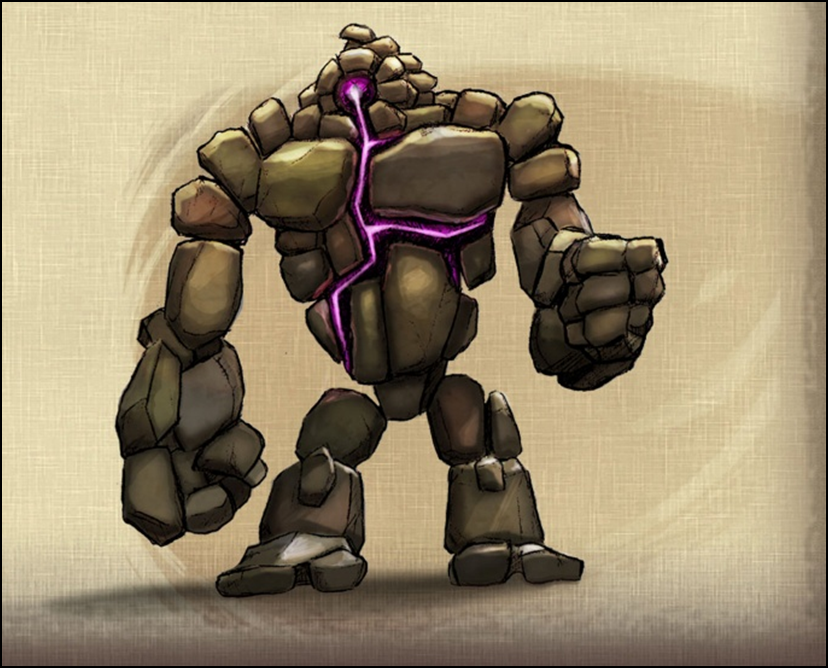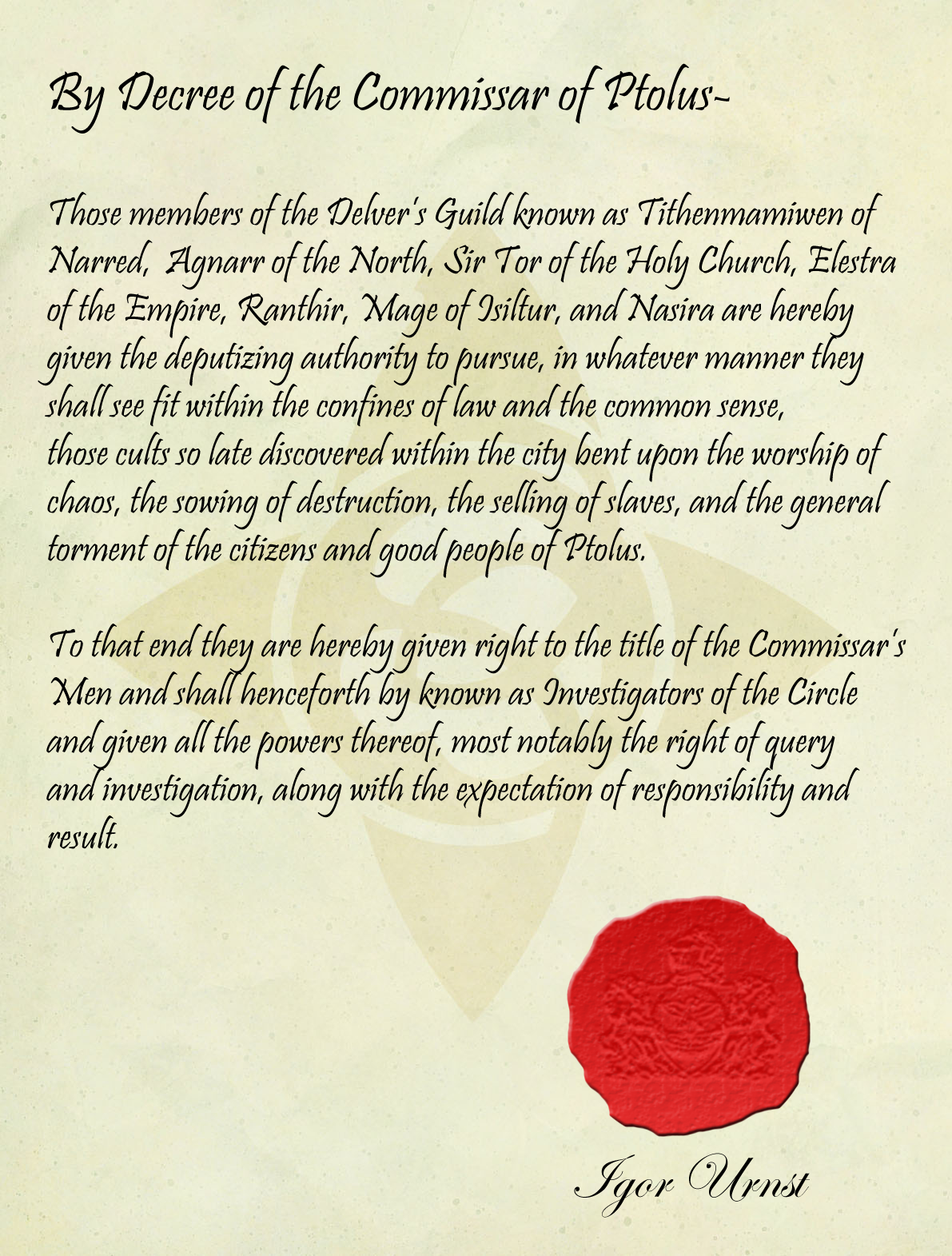
SESSION 45B: UPON A HILL OF CORPSE FLOWERS
October 31st, 2009
The 25th Day of Kadal in the 790th Year of the Seyrunian Dynasty
HOMUNCULI OF THE CITY
They wanted to get an early start the next day, but Elestra was still immersed in her meditations. And Tor had his training at the Godskeep. On the way there, Tor spontaneously decided to stop and purchase a bull whip. He had a few ideas for how it might come in useful.
While they waited for Tor to return, Tee grabbed the morning newssheets. The Columned Row Killer had struck again, but this time it had been seen in the act: A “tall, muscular creature with blue-black skin, glowing yellow eyes, and lanky black hair” had attacked a merchant passing through the Old City Gate. The creature had been driven off by the city guard, but not before leaving its victim in paralytic coma.
With a sinking feeling in their hearts, they recognized the description: It was the troll-spawn that had been freed from the Banewarrens. An evil that had been locked away for centuries now walked the streets of Ptolus.
Agnarr was also able to pick up the mage-touched chain that Hirus had been working on for Seeaeti. While the others discussed the troll-spawn, he took Seeaeti out near the Minstel’s stables and spent some time training him in the wearing of the mail.
Around noon, Tor returned to the Ghostly Minstrel and they went upstairs to check on Elestra. They found her missing: Her communion with the Spirit of the City had taken her on a walk-about through the streets of Ptolus, collecting bits of brick and rough cast which she eventually took to the heart of Midtown and there assembled into a geometrically fractal cairn. This final act of symbolic linkage complete, the cairn had risen up as the animated extrusion of the Spirit itself: A homunculus of the city.
Elestra returned to the Ghostly Minstrel and introduced the others to her new companion. They gathered in the common room for lunch and then left for the Necropolis.
POLLEN PLAGUE
With the information Ranthir had retrieved from the Administration Building on the 22nd they found the tomb easily enough. Near the apex of a gently sloping hill (which Ranthir’s papers named Darklock Hill) they spotted several stone sarsens jutting up from the ground, forming a rough and imperfect circle. Each of the sarsens bore the sigil of Alchestrin and were worn with age and crept-over with moss. The grass had grown tall around them, and here and there even taller plants had sprung up with broad, shiny leaves and brightly-colored flowers. More disturbingly, they could see the corpses of small animals scattered here and there around the sarsens.
A faint whiff of pungent decay wafted down the hill towards them, but they decided to brazenly ignore the animal carcasses and head straight up the hill towards the sarsens. As they drew near the circle, they could see in its center a large iron plug etched with bronze and set into the earth.
Before they could actually enter the circle, however, Agnarr spotted dark scales slithering through the grass – marking the passage of a massive, coal-black serpent with scales that glimmered like black ice beneath the stars. In its wake, it left a thin veil of frost upon the grass. At nearly twenty feet in muscle-rippled length, it must have been wrapped around one of the sarsens to escape their notice. Now it reared up, gaping a mouth from which issued faint plumes of glittering, icy mist.
Tor and Agnarr moved forward to meet the serpent, but as they did so a sudden nausea settled over the group. The serpent must have been exuding some sort of disquieting aura or perhaps noxious fumes. The effect only seemed to intensify as it focused the gaze of its coal-black eyes upon Nasira, locking her in a paralytic gaze that stopped her stone cold.
The nausea, which sent Tor reeling, disrupted their concerted attack and Agnarr – although largely unaffected – found himself getting bound in its icy, limb-numbing coils. Before the serpents’ tightening curves could draw tight, however, Agnarr was able to stretch his mighty thews and break free, sending the serpent spasming away.
But then the real panic set in as Tor started coughing up black blood and oozing black blood from his eyes. The symptoms of the others were beginning to worsen as well, and with only Agnarr fit to face the serpent, it seemed unlikely that its threat would be ended before they were all unconscious or dead or worse.
Fortunately, Tee – trying to suppress a cough that seemed as if it would rip out her lungs – spotted one of the tall, brightly-colored flowers turning towards them with an almost sadistic purpose. Making an intuitive leap she realized that the flowers – not the serpent – were the true source of the noisome plague. She shouted out a warning to the others while lurching towards the nearest flower, but her weakly-swung sword failed to produce any effect on its thick, armored stalk as she collapsed.
Ranthir and Elestra, meanwhile, managed to retreat to a safe distance. Near the foot of the hill they discovered that they were beyond the plague-pollen of the flowers. With her lungs almost immediately alleviated, Elestra sent her homunculus to start hauling people to a safe distance.
Then Agnarr managed to finally plunge his flaming sword down the icy throat of the ebon snake. Wrenching his blade free he swung it towards the nearest corpse flower, but as he hacked it apart the flower exploded in a massive cloud of poisonous vapor and pollen – a visible blackening of the air that seemed to cling to skin and eyes, clawing its way through mouth and nose and down into the lungs.
Agnarr (at the heart of the explosion) and Ranthir (caught unexpectedly in its edge) collapsed. Elestra, in a panic, rushed in to heal the badly wounded Agnarr… and promptly collapsed from the pervasive pollen of the remaining flowers.
Thus all of them were unconscious upon the flanks of the hill, their bodies being slowly consumed by the plague pollen.
Fortunately, the homunculus continued carrying out its last orders: To carry the unconscious to the base of the hill and out of the pollen cloud. Several of those who were hopelessly ill before managed to recover once they were taken far enough away from the flowers and they were able to tend to the rest.
Once everyone had been restored to at least a semblance of health, they backed off to an even safer distance and then sent the homunculus to kill the rest of the flowers.
Running the Campaign: Monster + Environment – Campaign Journal: Session 45C
In the Shadow of the Spire: Index
















